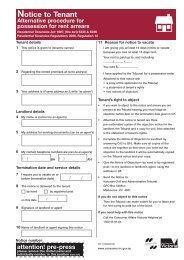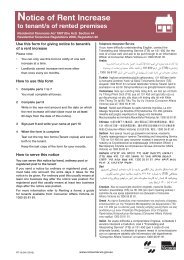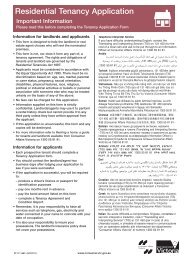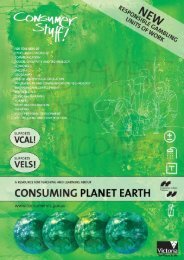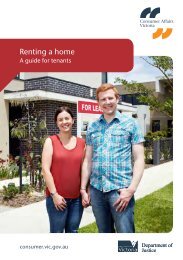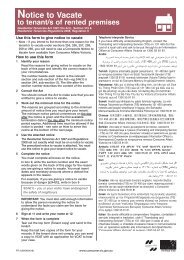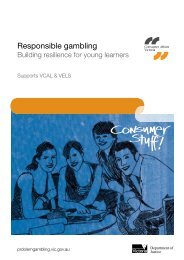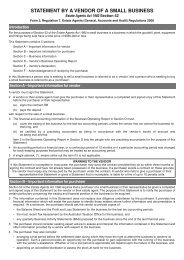Consumer Stuff for kids (PDF, 6.2 MB) - Consumer Affairs Victoria
Consumer Stuff for kids (PDF, 6.2 MB) - Consumer Affairs Victoria
Consumer Stuff for kids (PDF, 6.2 MB) - Consumer Affairs Victoria
You also want an ePaper? Increase the reach of your titles
YUMPU automatically turns print PDFs into web optimized ePapers that Google loves.
Using a mind map group the charities according<br />
to their purpose.<br />
For example: environmental, animal welfare, <strong>for</strong><br />
the poor and show linkages.<br />
Group the businesses. Grouping businesses could<br />
be done by: location, size, goods or services,<br />
industry (sports industry, fashion industry, food<br />
industry).<br />
In groups students are allocated a series of<br />
statements to discuss.<br />
1. Businesses make money easily.<br />
2. Charities only help the poor.<br />
3. Profit is important to businesses.<br />
4. Our school would be no different if<br />
parents stopped raising money.<br />
5. Everyone working <strong>for</strong> a charity gets paid.<br />
6. People feel good working <strong>for</strong> a charity.<br />
7. All businesses make lots of money.<br />
Groups report back and make a small<br />
presentation about their statement explaining why<br />
they believe the statement is true or false.<br />
Following each group’s presentation ask <strong>for</strong><br />
feedback from the class.<br />
Guiding Question:<br />
What does a business try to do and what does a<br />
charity organisation try to do?<br />
Students use a 2 column table and list the<br />
purpose of each.<br />
What does a businesses<br />
try to do?<br />
What does a charity<br />
try to do?<br />
Using a highlighter pen students identify<br />
similarities and differences.<br />
Remind students that successful businesses:<br />
• provide goods or services that consumers<br />
want at a price they will pay. The price<br />
includes a profit <strong>for</strong> the company.<br />
• Charities or fundraising organisations must<br />
maximize income and minimise expenses.<br />
This way maximum money will be raised.<br />
Students will:<br />
• use their existing knowledge to identify<br />
what a business and a charity means<br />
• provide examples of each.<br />
Assess students’ understanding about what<br />
it means to be a business or a charity.<br />
Students will:<br />
• explore issues facing businesses and charities<br />
• recognise stereotypes associated with<br />
charities and businesses<br />
• understand businesses and charities need to<br />
generate cash flow to achieve their goals.<br />
• explore different and new perceptions about<br />
the importance of charities<br />
Guide students to consider:<br />
• Businesses and charity organisations both<br />
need to earn money.<br />
• Volunteer work is common in charity<br />
organisations.<br />
• Charities usually specialise in one area such<br />
as the environment (Planet Ark), a school<br />
(Parents Association), the poor (World Vision),<br />
animal welfare (RSPCA).<br />
Assess students' understanding about how<br />
businesses and charities make money.<br />
96 CONSUMER AFFAIRS VICTORIA NEED CONSUMER HELP? 1300 55 81 81 www.consumer.vic.gov.au



